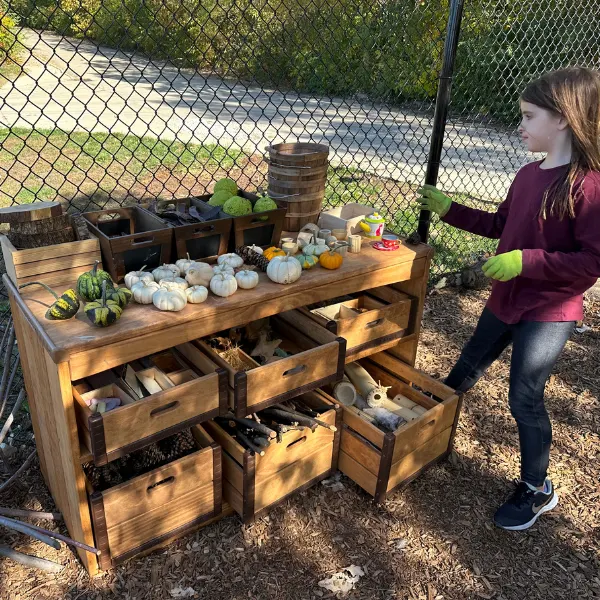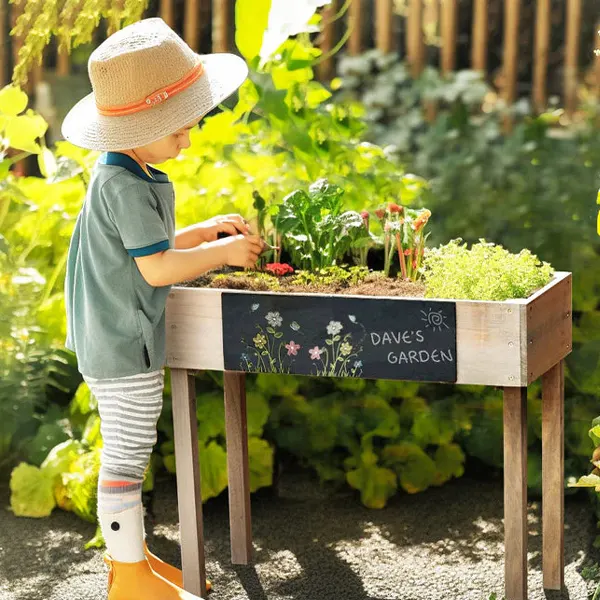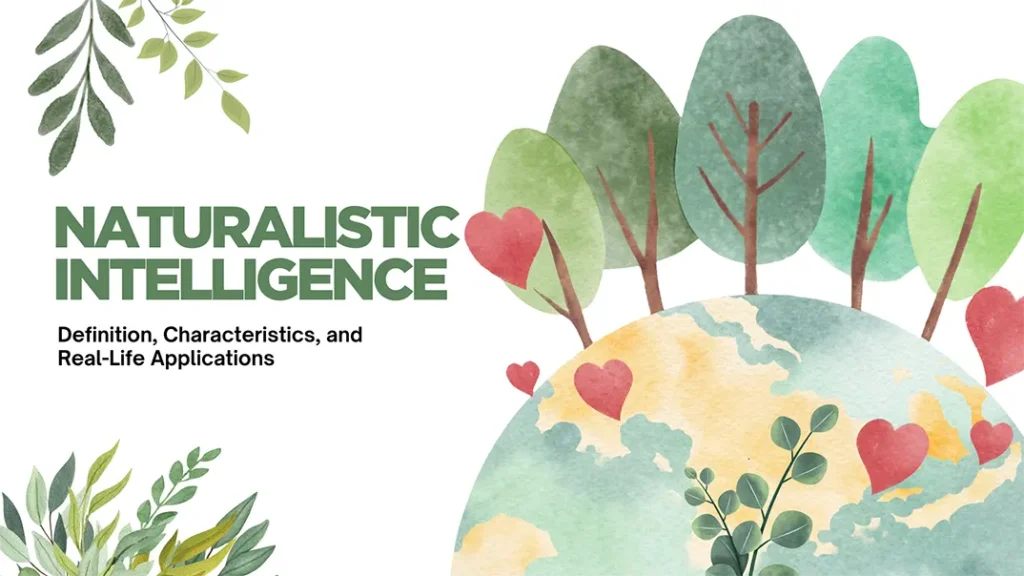Alcune persone sono particolarmente abili nel cogliere i dettagli del mondo naturale. Riescono a distinguere facilmente diverse piante, a riconoscere i modelli meteorologici o a sentirsi a proprio agio trascorrendo del tempo all'aria aperta. Questi punti di forza non sono solo preferenze personali; sono segni di una capacità nota come intelligenza naturalistica. Ma cosa rende unica questa forma di intelligenza e perché alcuni individui sembrano possederla più di altri?
L'intelligenza naturalistica, una delle intelligenze multiple di Howard Gardner, è la capacità di riconoscere, categorizzare e interagire con gli elementi della natura. Le persone con una forte intelligenza naturalistica possono identificare le specie, osservare i modelli ambientali e comprendere le relazioni ecologiche con notevole chiarezza. Questa intelligenza non solo supporta la ricerca scientifica e la consapevolezza ambientale, ma aiuta anche i bambini a sviluppare capacità di problem solving e una più profonda comprensione del pianeta.
Questo articolo esplorerà la definizione e le caratteristiche dell'intelligenza naturalistica, le strategie pratiche per identificarla e supportarla e le sue applicazioni pratiche nell'istruzione e nella vita quotidiana. Continuate a leggere per scoprire come l'intelligenza naturalistica può trasformare il modo in cui i bambini apprendono e interagiscono con il mondo che li circonda.
Cos'è l'intelligenza naturalistica?
L'intelligenza naturalistica è la capacità di identificare, osservare e comprendere gli elementi dell'ambiente naturale, tra cui piante, animali, condizioni meteorologiche e altri sistemi ecologici. Le persone con una forte intelligenza naturalistica tendono ad essere curiose del mondo naturale, amano le attività all'aria aperta e sono spesso abili nel riconoscere i modelli presenti in natura.
Il concetto di intelligenza naturalistica deriva dalla teoria delle intelligenze multiple di Howard Gardner, che sottolinea come l'intelligenza non sia un'unica misura, ma una varietà di modi in cui le persone apprendono, elaborano ed esprimono la comprensione. Gardner ha ipotizzato che ogni bambino possieda una combinazione unica di queste intelligenze e che riconoscerle aiuti educatori e genitori a supportare diversi stili di apprendimento.
Teoria delle intelligenze multiple
- Intelligenza linguistica: sensibilità al linguaggio parlato e scritto, alla narrazione e ai giochi di parole.
- Intelligenza logico-matematica: capacità di analizzare i problemi, usare il ragionamento e lavorare con i numeri.
- Intelligenza musicale: la capacità di riconoscere ritmo, altezza e schemi sonori.
- Intelligenza corporeo-cinestetica: abilità nell'usare il proprio corpo per esprimersi, muoversi e risolvere problemi.
- Intelligenza visiva spaziale: la capacità di visualizzare, creare immagini mentali e pensare in tre dimensioni.
- Intelligenza interpersonale: sensibilità agli stati d'animo, ai sentimenti e alle motivazioni altrui.
- Intelligenza intrapersonale: consapevolezza di sé e capacità di riflettere sui propri pensieri ed emozioni.
- Intelligenza naturalistica: la capacità di comprendere e interagire con la natura, notando modelli, sistemi e relazioni nell'ambiente.
Costrutti mentali dell'intelligenza naturalistica
Per comprendere il funzionamento dell'intelligenza naturalistica, è utile analizzare gli specifici processi cognitivi e mentali che la rendono unica. Questi costrutti spiegano come gli individui riconoscono, classificano e interpretano i modelli del mondo naturale.
1. Orientamento agli attributi
Le persone con una forte intelligenza naturalistica hanno la capacità di notare somiglianze e tratti comuni tra oggetti, organismi o elementi naturali. Ad esempio, un bambino può raggruppare le conchiglie in base al colore o al motivo, oppure un adulto può identificare caratteristiche comuni tra diverse specie di uccelli. Questo orientamento agli attributi consente loro di individuare rapidamente connessioni e distinzioni che altri potrebbero trascurare.
2. Categorizzazione
Un altro elemento chiave è la capacità di ordinare ed etichettare in base a caratteristiche o caratteristiche. Questo si nota quando gli studenti classificano le piante in gruppi come erbe, arbusti e alberi, o quando distinguono tra mammiferi, rettili e anfibi. Tale categorizzazione aiuta a strutturare la conoscenza e ad approfondire la comprensione della biodiversità.
3. Ragionamento gerarchico
Oltre al semplice raggruppamento, l'intelligenza naturalistica implica anche la classificazione o l'organizzazione degli elementi in base all'importanza, alla funzione o alla relazione. Ad esempio, gli studenti potrebbero creare un diagramma della catena alimentare che mostri produttori, consumatori e decompositori, oppure potrebbero organizzare i minerali in base ai livelli di durezza. Questo ragionamento aiuta a rivelare le interconnessioni all'interno degli ecosistemi.
4. Memoria schematica
Gli individui con spiccate capacità naturalistiche spesso ricordano le informazioni collegandole a categorie di attributi o strutture gerarchiche. Invece di memorizzare fatti casuali, ancorano le nuove conoscenze a schemi mentali preesistenti, ad esempio ricordando le tipologie di piante associandole alla forma delle foglie o alle preferenze del terreno. Questa memoria strutturata migliora la ritenzione a lungo termine.
5. Orientamento naturale
Forse la caratteristica più distintiva è la profonda sensibilità verso gli organismi viventi e il loro ambiente. Le persone con questo orientamento si sentono naturalmente attratte dall'osservazione della fauna selvatica, dalla cura dei giardini o dall'esplorazione degli spazi aperti. Più che un semplice riconoscimento, questo costrutto spesso porta a un senso di empatia per la natura, incoraggiando atteggiamenti conservativi e un pensiero sostenibile.

Caratteristiche dell'intelligenza naturalistica
L'intelligenza naturalistica è caratterizzata da una profonda sensibilità per il mondo naturale e dalla capacità di osservare, identificare e categorizzare gli elementi al suo interno. Le persone con questa forma di intelligenza non solo amano stare all'aria aperta, ma interagiscono attivamente con la natura, notando schemi e dettagli che altri potrebbero non notare. Ecco alcune delle caratteristiche più comuni degli individui con una forte intelligenza naturalistica:
- Capacità di osservazione potenziate:
Spesso notano sottili cambiamenti nel loro ambiente, come cambiamenti meteorologici, nella crescita delle piante o nel comportamento degli animali. Questi individui sono in grado di individuare modelli in natura che li aiutano a comprendere il funzionamento degli ecosistemi. - Forte capacità di classificazione:
Una caratteristica fondamentale dell'intelligenza naturalistica è la capacità di raggruppare gli elementi naturali in categorie. Che si tratti di classificare rocce, identificare specie vegetali o riconoscere tracce di animali, organizzano naturalmente ciò che vedono. - Collegamento con gli esseri viventi:
Le persone dotate di intelligenza naturalistica in genere sentono un forte legame emotivo ed etico con gli animali, le piante e la Terra stessa. Possono avere a cuore la conservazione, la sostenibilità e l'equilibrio ecologico. - Curiosità sul mondo naturale:
Fin da piccoli, questi individui mostrano spesso un vivo interesse nel collezionare oggetti naturali, come foglie, insetti o pietre, e nel porsi domande sul funzionamento dei sistemi naturali. - Comfort negli ambienti esterni:
Gli ambienti naturali sono spesso il luogo in cui queste persone si sentono più in pace. Che si tratti di escursioni, giardinaggio o semplicemente di osservazione, trovano energia e chiarezza negli ambienti naturali. - Imparare attraverso la natura:
Le persone con intelligenza naturalistica apprendono meglio quando i contenuti educativi sono legati a esempi ambientali del mondo reale. Possono prosperare in aule all'aperto o contesti di apprendimento sul campo. - Consapevolezza e responsabilità ambientale:
Spesso sono più consapevoli delle problematiche ambientali e possono essere motivati a proteggere e preservare le risorse della Terra attraverso sforzi personali o professionali.

Non limitarti a sognarlo, progettalo! Parleremo delle tue esigenze di arredamento personalizzato!
Esempi di intelligenza naturalistica in azione
Comprendere l'intelligenza naturalistica diventa più chiaro quando osserviamo come si manifesta nella vita di tutti i giorni. Questa forma di intelligenza non si limita alle aule scolastiche o alle carriere professionali: spesso emerge naturalmente sia nei bambini che negli adulti attraverso le loro attività quotidiane.
- Bambini che esplorano l'aria aperta
Molti bambini con una spiccata intelligenza naturalistica amano collezionare sassi, foglie o conchiglie. Possono trascorrere ore a osservare le formiche, a osservare le nuvole o a identificare i diversi tipi di alberi in un parco. La loro curiosità li spinge a esplorare e organizzare ciò che vedono in natura. - Bambini che raccolgono e ordinano oggetti
Un bambino trascorre del tempo in spiaggia raccogliendo conchiglie e poi le organizza per colore e forma. Questo semplice gesto riflette l'intelligenza naturalistica attraverso l'osservazione e la classificazione. - Riconoscere i modelli meteorologici
Uno studente nota che nuvole scure, vento improvviso e un calo di temperatura spesso indicano che presto pioverà. Prevedere i cambiamenti meteorologici dimostra spiccate capacità di osservazione e di riconoscimento di schemi. - Prendersi cura degli animali domestici e degli animali
Un adolescente si assume la responsabilità di nutrire il cane di famiglia, di pulire il suo spazio e di mostrare preoccupazione quando l'animale sembra non stare bene. Questa empatia verso gli animali dimostra una naturale affinità con gli esseri viventi. - Progetto di giardinaggio scolastico
In un'attività in classe, i bambini piantano ortaggi, ne monitorano la crescita e confrontano i risultati tra piante esposte alla luce del sole e piante all'ombra. Questo stimola sia la curiosità che il ragionamento scientifico, strettamente legato all'intelligenza naturalistica.
I benefici dell'intelligenza naturalistica
L'intelligenza naturalistica offre ai bambini molto più del semplice apprezzamento per la vita all'aria aperta. Svolge un ruolo essenziale nel plasmare le loro esperienze di apprendimento, la loro crescita personale e le loro competenze future. Se coltivata, questa forma di intelligenza aiuta i bambini a sviluppare capacità cognitive, consapevolezza emotiva e responsabilità sociale.

Promuove la curiosità e l'amore per l'apprendimento
I bambini con una forte intelligenza naturalistica spesso si pongono domande come: "Perché gli uccelli volano verso sud?" o "Che tipo di albero è questo?". La loro naturale curiosità li spinge a esplorare, osservare e indagare. Questa mentalità investigativa si traduce in un interesse più profondo per l'apprendimento, non solo per la natura, ma anche per discipline come la scienza, la geografia e persino la narrazione. Quando collegano ciò che apprendono alle osservazioni del mondo reale, sviluppano un genuino entusiasmo per l'apprendimento.
Incoraggia l'apprendimento pratico ed esperienziale
I bambini con questa forma di intelligenza prosperano quando possono coinvolgere i propri sensi. Invece di imparare solo attraverso i libri di testo, preferiscono toccare le foglie, scavare nel terreno o osservare gli animali in azione. Attività come piantare semi o osservare i cambiamenti meteorologici rendono l'apprendimento più concreto e memorabile. Queste esperienze pratiche rafforzano i concetti accademici, mantenendo i bambini coinvolti e coinvolti.
Supporta il benessere emotivo e mentale
È stato dimostrato che trascorrere del tempo in ambienti naturali riduce lo stress, migliora l'umore e promuove l'equilibrio emotivo nei bambini. Chi ha un'intelligenza naturalistica spesso cerca pace e conforto nella natura, usandola come spazio per rilassarsi o riflettere. Che si tratti di osservare le nuvole, passeggiare in un parco o semplicemente sedersi sotto un albero, la natura li aiuta a sentirsi calmi e radicati, un fattore essenziale per la salute mentale e lo sviluppo emotivo.
Sviluppa responsabilità ed empatia
I bambini che si prendono cura di piante, animali o persino piccoli ecosistemi imparano l'importanza della responsabilità. Nutrire un animale domestico, annaffiare una pianta o pulire un'aiuola li aiuta a capire che gli esseri viventi dipendono dalle loro azioni. Questo senso di responsabilità spesso si estende all'empatia, man mano che iniziano a riconoscere i bisogni e i sentimenti sia degli esseri viventi che dell'ambiente.
Migliora la concentrazione e l'attenzione
Gli ambienti naturali stimolano i sensi senza sopraffarli. I bambini che interagiscono regolarmente con la natura mostrano spesso una maggiore capacità di attenzione e una migliore concentrazione, soprattutto in ambienti con molti schermi. Per i bambini con difficoltà di attenzione, attività come passeggiate nella natura, birdwatching o monitoraggio della crescita delle piante possono migliorare la concentrazione attraverso un delicato coinvolgimento sensoriale.
Sviluppa capacità di osservazione e classificazione
Un bambino che ordina le pietre in base al colore, alla forma o alla consistenza esercita il pensiero scientifico precoce. L'intelligenza naturalistica incoraggia l'abitudine a notare schemi, fare confronti e organizzare le osservazioni: competenze fondamentali per la scienza, la matematica e il ragionamento analitico. Queste capacità aiutano i bambini a sviluppare un pensiero chiaro e un modo strutturato di comprendere il mondo.
Incoraggia una sana attività fisica
I bambini attratti dalla natura spesso si dedicano ad attività fisiche come l'arrampicata, la corsa o l'esplorazione di sentieri. Queste attività promuovono lo sviluppo motorio, la coordinazione e la forma fisica generale. A differenza dell'esercizio fisico strutturato in casa, il movimento in mezzo alla natura è spontaneo e piacevole, rendendo più facile per i bambini rimanere attivi e in salute.
Instilla la consapevolezza ambientale fin dalla tenera età
Quando i bambini si sentono in contatto con la natura, diventano naturalmente più consapevoli delle problematiche ambientali. Potrebbero chiedersi perché un albero è stato abbattuto o perché un certo uccello ha smesso di visitare il loro giardino. Queste domande segnano l'inizio della consapevolezza ambientale. Crescendo, questa consapevolezza precoce si trasforma spesso in comportamenti più responsabili e sostenibili, sia a casa che nella comunità.
Non limitarti a sognarlo, progettalo! Parleremo delle tue esigenze di arredamento personalizzato!
Segni di elevata intelligenza naturalistica nei bambini
| Cartello | Esempio | Tratto |
|---|---|---|
| Forte curiosità per la natura | Pone frequentemente domande come: "Perché le foglie cambiano colore?" O "Che tipo di uccello è questo?" | Mostra una naturale spinta ad esplorare e comprendere l'ambiente |
| Amore per l'esplorazione all'aria aperta | Trascorre il tempo a raccogliere rocce, osservare insetti o osservare le nuvole con più attenzione dei suoi coetanei | Preferisce esperienze immersive nella natura rispetto a brevi interazioni |
| Capacità di classificazione e ordinamento | Raggruppa le conchiglie per forma o colore, oppure organizza i fiori per tipo | Dimostra pensiero logico e organizzazione sistematica |
| Empatia per gli esseri viventi | Sposta un insetto con cautela invece di calpestarlo, o insiste nel dare da mangiare regolarmente agli animali domestici | Dimostra sensibilità, cura e compassione verso gli esseri viventi |
| Abilità di osservazione acuta | Nota sottili cambiamenti nel cielo prima che piova o distingue tra piante simili | Possiede una forte attenzione ai dettagli e al riconoscimento degli schemi |
| Consapevolezza ambientale precoce | Ricorda alla famiglia di riciclare, risparmiare acqua o spegnere le luci non utilizzate | Dimostra responsabilità e consapevolezza delle problematiche ecologiche |
| Preferenza per l'apprendimento legato alla natura | Eccelle nei progetti di giardinaggio, negli esperimenti scientifici sugli ecosistemi o nella tenuta di un diario naturalistico | Impara meglio quando le attività sono collegate al mondo naturale |
Come sviluppare l'intelligenza naturalistica?
Lo sviluppo dell'intelligenza naturalistica nei bambini è un processo graduale che si basa sull'ambiente, sulla guida e sui valori, piuttosto che su lezioni isolate. Creando un contesto di supporto, genitori ed educatori possono incoraggiare i bambini a riconoscere, interrogarsi e connettersi con il mondo naturale in modi significativi.

Creare un ambiente ricco di natura
I bambini sviluppano un'intelligenza naturalistica più forte quando i loro spazi di apprendimento riflettono la bellezza e le texture della natura stessa. Aule e case che includono luce naturale, verde ed elementi di design eco-compatibili stimolano la curiosità e aiutano i bambini a sentirsi più connessi con l'ambiente. Un modo efficace per raggiungere questo obiettivo è attraverso l'uso di mobili in legno, che conferisce calore, resistenza e un'estetica naturale alle aree didattiche. A differenza della plastica o del metallo, i materiali in legno sono più vicini alla natura, incoraggiando i bambini ad apprezzare le texture organiche e le risorse sostenibili.
Nelle aule, gli insegnanti possono creare spazi ricchi di natura combinando piante, angoli di apprendimento all'aperto e collezioni di oggetti naturali. A casa, i genitori possono progettare aree a misura di bambino che includano esposizioni naturali e opportunità di interazione diretta con gli esseri viventi. Per rendere questi ambienti funzionali e stimolanti, considerate i seguenti mobili e giocattoli in legno:



- Librerie e unità espositive: ideale per organizzare libri a tema naturalistico, collezioni di rocce, conchiglie o diari di classe.
- Tavoli e sedie per attività: robusto mobili da interno per progetti di gruppo come ordinare le foglie, classificare gli insetti o disegnare osservazioni.
- Unità di stoccaggio: scomparti per tenere in ordine lenti di ingrandimento, guide di campo o collezioni stagionali.
- Set di giochi di finzione: set a tema fattoria, giardino o animali che incoraggiano il gioco di ruolo e la narrazione legati alla natura.
- Blocchi da costruzione e set di habitat: giocattoli che consentono ai bambini di costruire paesaggi, foreste o ecosistemi in miniatura.
- Tavoli da sabbia e acqua per esterni: postazioni pratiche in cui i bambini possono esplorare materiali naturali, sperimentare con le texture e osservare il rapporto causa-effetto.
- Strutture di arrampicata e travi di equilibrio: attrezzature da gioco all'aperto che sviluppa le capacità motorie e al contempo avvicina i bambini al movimento naturale.
- Kit da giardinaggio e fioriere: attrezzi a misura di bambino, aiuole rialzate o piccole fioriere per far crescere fiori, verdure o erbe aromatiche.
- Kit di esplorazione della natura: binocoli, acchiappa-insetti e lenti di ingrandimento che rendono le avventure all'aria aperta più coinvolgenti.
La tua classe perfetta è a un clic di distanza!
Promuovere un senso di meraviglia per la natura
Incoraggiate i bambini a porre domande, fare osservazioni e riflettere criticamente su ciò che vedono intorno a loro. Invece di affrettarsi a fornire risposte, create spazio affinché la curiosità possa crescere. Questo incoraggia il pensiero indipendente e un più profondo apprezzamento per i sistemi viventi.
- Invitali a notare i cambiamenti del tempo o delle stagioni
- Incoraggia domande come "Cosa pensi che sia questo?"
- Utilizzare storie o libri che evidenziano i misteri della natura
Incoraggiare l'apprendimento basato sulla ricerca
L'intelligenza naturalistica si sviluppa quando i bambini sono incoraggiati a porre domande e a cercare risposte autonomamente. Invece di limitarsi a memorizzare i fatti, dovrebbero essere guidati a indagare modelli, confrontare oggetti e interpretare ciò che vedono. Questo approccio rafforza il pensiero critico e permette ai bambini di stabilire connessioni personali con l'ambiente.
Integrare la natura nella routine quotidiana
Genitori e insegnanti possono favorire la crescita naturalistica integrando la natura nelle routine quotidiane. Osservare il meteo prima di andare a scuola, notare i cambiamenti stagionali o parlare delle stelle di notte sono modi semplici per introdurre la consapevolezza naturalistica nella vita quotidiana di un bambino. Queste piccole ma costanti esperienze alimentano le capacità di osservazione nel tempo.
Coltivare la pazienza e le capacità di osservazione
I processi naturali richiedono tempo. Incoraggiate i bambini a rallentare, a osservare i cambiamenti nel corso di giorni o settimane e a riflettere su ciò che vedono. Questo sviluppa la pazienza e allena la loro attenzione ai dettagli.
- Osserva la crescita delle piante per giorni o settimane
- Tieni traccia dei cambiamenti in un albero o in un appezzamento di giardino
- Osserva uccelli o insetti e registra i comportamenti
Modellazione dell'apprezzamento ambientale
I bambini spesso imitano i comportamenti degli adulti. Quando vedono genitori e insegnanti riciclare, fare giardinaggio o mostrare rispetto per animali e piante, iniziano a dare valore alla natura. Dando l'esempio della cura dell'ambiente, gli adulti insegnano ai bambini che la natura merita di essere protetta e rispettata.
Supportare le connessioni interdisciplinari
La natura non è solo una materia scientifica, ma è anche strettamente connessa all'arte, al linguaggio e alla geografia. Incoraggiare i bambini a disegnare ciò che osservano, a scrivere storie ispirate alle esperienze all'aria aperta o a collegare i modelli naturali alle mappe li aiuta a integrare la loro intelligenza naturalistica in un apprendimento più ampio.
- Utilizzare foglie o sassi per l'ordinamento/il conteggio matematico
- Includere temi naturalistici nella narrazione o nella scrittura
- Discutere argomenti ambientali in ambito scientifico o sociale

Valorizzare i punti di forza individuali
Ogni bambino esprime l'intelligenza naturalistica in modi unici. Alcuni possono essere abili nel riconoscere le specie vegetali, mentre altri possono essere affascinati dal clima o dal comportamento degli animali. Riconoscendo e incoraggiando queste differenze, genitori ed educatori danno ai bambini la fiducia necessaria per sviluppare i propri punti di forza naturalistici e applicarli in diversi contesti di apprendimento.
Incoraggiare la riflessione e la connessione
Chiedete ai bambini come li fa sentire la natura o cosa hanno imparato trascorrendo del tempo all'aria aperta. Questo contatto personale aiuta a rafforzare il loro legame con l'ambiente e rafforza la motivazione interiore a prendersene cura.
- Chiedi: "Cosa ti è piaciuto di più oggi?"
- Utilizzare il disegno o la scrittura di un diario per esprimere le esperienze nella natura
- Discutere di sensazioni come calma o eccitazione dopo il tempo trascorso all'aria aperta
Attività per stimolare l'intelligenza naturalistica
Le attività pratiche sono uno dei modi più efficaci per coltivare l'intelligenza naturalistica nei bambini. Offrendo loro opportunità concrete di interagire con il mondo naturale, genitori ed educatori possono trasformare la curiosità in esperienze di apprendimento significative. Gli esempi seguenti mostrano come l'intelligenza naturalistica possa essere coltivata sia in classe che a casa.
1. Passeggiate nella natura con uno scopo
Una passeggiata nella natura diventa molto più di una semplice passeggiata quando i bambini sono incoraggiati a osservare elementi specifici come tracce di animali, tipi di piante o cambiamenti meteorologici. Queste passeggiate mirate affinano la consapevolezza sensoriale, stimolano la curiosità e aiutano i bambini a iniziare a cogliere i modelli e le storie presenti nel loro ambiente.

2. Giardinaggio e cura delle piante
Il giardinaggio permette ai bambini di partecipare all'intero ciclo vitale delle piante, dalla semina alla raccolta di cibo o fiori. Attraverso la cura e l'osservazione regolari, imparano la pazienza, la responsabilità e il modo in cui luce solare, acqua e terreno interagiscono per sostenere i sistemi viventi.
3. Costruire un hotel per insetti o una mangiatoia per uccelli
Creare un hotel per insetti o una mangiatoia per uccelli offre ai bambini l'opportunità di sostenere la fauna selvatica locale e di imparare a conoscerne il comportamento. Una volta posizionate all'esterno, queste semplici strutture invitano all'osservazione, offrendo una finestra sulle abitudini di insetti o uccelli in modo personale e continuativo.
4. Ordinamento e classificazione degli oggetti naturali
Raccogliere foglie, sassi o conchiglie e classificarli in base a caratteristiche come colore, consistenza o forma aiuta i bambini a sviluppare capacità di riconoscimento di schemi e classificazione. Questa attività pratica stimola il pensiero analitico, rendendo l'apprendimento un gioco.
5. Diario meteorologico
Tenere un diario meteorologico incoraggia l'osservazione quotidiana e la riflessione a lungo termine. I bambini possono annotare la temperatura, il tipo di nuvole e le precipitazioni mentre disegnano o scrivono ciò che vedono. Col tempo, iniziano a notare i modelli stagionali e l'impatto del meteo sulla natura.
6. Osservazione del comportamento animale
Osservare gli animali, che si tratti di uccelli alla mangiatoia, insetti in giardino o un animale domestico, insegna ai bambini a rallentare e a notare movimenti, suoni e comportamenti. Questo tipo di osservazione alimenta l'empatia, la pazienza e una migliore comprensione di come gli animali interagiscono con il loro ambiente.
7. Progetti artistici basati sulla natura
Utilizzando materiali naturali come foglie, bastoncini, pietre e fiori, i bambini possono creare opere d'arte che collegano la creatività alla natura. Realizzare mandala, disegni di foglie o sculture di bastoncini arricchisce le loro esperienze sensoriali e li aiuta a vedere la natura attraverso una lente artistica.

8. Gite scolastiche a centri naturalistici o fattorie
Visitare fattorie, acquari o centri naturalistici offre ai bambini un'esperienza pratica con gli ecosistemi e gli sforzi di conservazione. Queste esperienze rendono concetti come biodiversità, sistemi alimentari e conservazione degli habitat più tangibili e significativi.
9. Creare un mini ecosistema
Progettare un terrario o un piccolo giardino acquatico permette ai bambini di osservare il funzionamento dei sistemi viventi. Osservare come crescono le piante, si sviluppano i cicli di umidità e si mantiene l'equilibrio all'interno di un ambiente protetto favorisce l'osservazione e la comprensione a lungo termine.
10. Sfide stagionali della natura
Le famiglie possono creare delle tradizioni legate all'osservazione dei cambiamenti stagionali, come osservare il cambiamento di colore degli alberi in autunno o osservare quali uccelli compaiono in primavera. Questi rituali incoraggiano i bambini a prestare attenzione ai cicli naturali e a sviluppare un senso del tempo radicato nell'ambiente.
Personaggi famosi con elevata intelligenza naturalistica
Nel corso della storia, molti personaggi noti hanno dimostrato un'eccezionale intelligenza naturalistica. La loro capacità di osservare, classificare e connettersi con il mondo naturale non solo ha plasmato le scoperte scientifiche, ma ha anche ispirato generazioni ad apprezzare e proteggere l'ambiente.



- Carlo Darwin
Charles Darwin è uno degli esempi più emblematici di intelligenza naturalistica. La sua attenta osservazione di piante, animali ed ecosistemi durante il suo viaggio a bordo dell'HMS Beagle portò alla rivoluzionaria teoria dell'evoluzione per selezione naturale. La scrupolosa attenzione ai dettagli e la capacità di Darwin di classificare le specie evidenziano l'essenza dell'intelligenza naturalistica in azione. - Jane Goodall
Lo studio durato una vita di Jane Goodall sugli scimpanzé in Tanzania dimostra il potere dell'osservazione paziente e dell'empatia per le creature viventi. La sua intelligenza naturalistica le ha permesso di comprendere il comportamento animale a un livello profondo e il suo lavoro continua a ispirare l'educazione ambientale, la conservazione e il rispetto per la fauna selvatica in tutto il mondo. - John Muir
Noto come il "Padre dei Parchi Nazionali", John Muir unì una spiccata intelligenza naturalistica alla passione per la conservazione. I suoi scritti e la sua attività di sensibilizzazione hanno sottolineato la bellezza e l'importanza della natura selvaggia, portando alla creazione di diversi parchi nazionali negli Stati Uniti. La sua eredità dimostra come l'intelligenza naturalistica possa influenzare le politiche ambientali e i valori culturali. - Rachele Carson
Rachel Carson, autrice di Primavera silenziosa, ha utilizzato la sua intelligenza naturalistica per collegare la scienza ecologica alla consapevolezza pubblica. Osservando attentamente gli ecosistemi e sottolineando i pericoli dei pesticidi, ha dato vita al moderno movimento ambientalista. La sua capacità di comunicare i modelli e i rischi della natura riflette una solida applicazione dell'intelligenza naturalistica. - EO Wilson
EO Wilson, biologo e pioniere nello studio della biodiversità, ha esemplificato l'intelligenza naturalistica attraverso la sua profonda conoscenza delle formiche e degli ecosistemi. La sua capacità di individuare connessioni tra specie e habitat ha contribuito al concetto di "biofilia", l'idea che gli esseri umani abbiano un legame innato con il mondo naturale.
Carriere per l'intelligenza naturalistica
I bambini che mostrano una forte intelligenza naturalistica spesso diventano adulti capaci di prosperare in professioni legate alla natura, alla scienza e all'ambiente. La loro capacità di osservare i dettagli, riconoscere modelli e prendersi cura dei sistemi viventi può tradursi in carriere significative che combinano passione e impatto pratico. Riconoscendo precocemente queste possibilità, genitori ed educatori possono incoraggiare i bambini a considerare i propri punti di forza naturalistici come preziosi per il futuro.

- Scienziato ambientale
Gli scienziati ambientali studiano gli ecosistemi, il clima e l'impatto umano sull'ambiente. Un bambino affascinato dai cambiamenti climatici o dai problemi di inquinamento potrebbe un giorno intraprendere questa carriera per proteggere le risorse naturali e promuovere la sostenibilità. - Biologo o zoologo
I bambini che amano gli animali e mostrano un forte interesse per la classificazione e l'osservazione potrebbero essere attratti dalla biologia o dalla zoologia. Queste carriere permettono loro di studiare in dettaglio specie, habitat e relazioni ecologiche. - Botanico o orticoltore
Per i bambini affascinati dalle piante, dal giardinaggio e dai cicli di crescita, le carriere in botanica o orticoltura offrono l'opportunità di studiare la vita vegetale, sviluppare sistemi agricoli o progettare giardini e paesaggi sostenibili. - Conservazionista o guardia forestale
Alcuni bambini potrebbero sognare di lavorare all'aria aperta, proteggere gli spazi naturali ed educare le comunità. I ruoli nella conservazione o come guardie forestali consentono loro di salvaguardare gli ecosistemi e ispirare gli altri a rispettare la natura. - Specialista agricolo
I bambini che amano le attività pratiche legate all'agricoltura, alla produzione alimentare o allo studio del suolo possono intraprendere carriere agricole. Queste professioni combinano intelligenza naturalistica con competenze pratiche per garantire la sicurezza alimentare e la tutela dell'ambiente. - Educatore ambientale
Per coloro che amano condividere la conoscenza e guidare gli altri, l'insegnamento dell'educazione ambientale offre un modo per ispirare le generazioni future. L'intelligenza naturalistica li aiuta a spiegare concetti ecologici complessi in modi comprensibili per bambini e comunità.
Non limitarti a sognarlo, progettalo! Parleremo delle tue esigenze di arredamento personalizzato!
Domande frequenti
- Perché l'intelligenza naturalistica è importante per lo sviluppo del bambino?
Incoraggia l'osservazione, il pensiero critico, la creatività e la responsabilità verso l'ambiente. I bambini con intelligenza naturalistica ne traggono beneficio anche a livello emotivo, poiché il tempo trascorso nella natura riduce lo stress e promuove il benessere. - L'intelligenza naturalistica può essere sviluppata nei bambini che non la mostrano naturalmente?
Sì. Anche se un bambino non mostra forti inclinazioni naturalistiche, l'esposizione alla natura attraverso il giardinaggio, il gioco all'aria aperta e le attività di osservazione può rafforzare il suo apprezzamento e le sue competenze in questo ambito. - A che età solitamente si manifesta nei bambini l'intelligenza naturalistica?
I segni di intelligenza naturalistica emergono spesso nella prima infanzia. Anche i bambini in età prescolare possono mostrare curiosità collezionando pietre, osservando insetti o ponendo domande su animali e piante. Con un po' di incoraggiamento, queste tendenze possono svilupparsi ulteriormente durante gli anni scolastici. - I bambini con intelligenza naturalistica preferiscono sempre giocare all'aria aperta?
Non sempre. Mentre molti amano le attività all'aria aperta, alcuni possono esprimere la loro intelligenza naturalistica disegnando piante, leggendo di animali o organizzando collezioni di oggetti naturali in casa. Il loro legame con la natura può assumere molteplici forme. - Quali sfide potrebbero incontrare a scuola i bambini con una forte intelligenza naturalistica?
Alcuni bambini potrebbero avere difficoltà nelle classi tradizionali se i loro punti di forza naturalistici non vengono riconosciuti. Potrebbero disinteressarsi alle lezioni astratte, ma prosperare quando l'apprendimento include esperienze all'aperto, progetti pratici o esempi concreti.
Conclusione
L'intelligenza naturalistica ci ricorda che l'apprendimento non avviene solo tra le mura di un'aula scolastica. Per i bambini, la capacità di riconoscere, classificare e connettersi con il mondo naturale è una potente forma di intelligenza che plasma la loro curiosità, il pensiero critico e il senso di responsabilità. Valorizzando questa capacità, genitori ed educatori aprono le porte a un'osservazione più profonda, a una maggiore capacità di problem solving e a un apprezzamento duraturo per l'ambiente.



